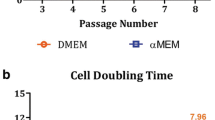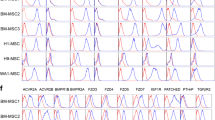Abstract
Bone marrow-derived human mesenchymal stem cells (BM-hMSCs) represent a promising cell-based therapy for a number of degenerative conditions. Many applications require cell expansion and involve the treatment of diseases and conditions found in an aging population. Therefore, the effects of donor age and long-term passage must be clarified. In this study, the effects of donor age and long-term passage on the morphology, proliferation potential, characteristics, mesodermal differentiation ability, and transdifferentiation potential of hMSCs towards neurogenic lineage were evaluated. Cells from child donors (0–12 years, n = 6) maintained their fibroblast-like morphology up to higher passages and proliferated in a greater number than those from adult (25–50 years, n = 6) and old (over 60 years, n = 6) donors. Adipogenic, osteogenic, and neurogenic differentiation potential decreased with age, while chondrogenic potential did not change. Long-term passage affected the morphology and proliferation of hMSCs from all ages. With increasing passage number, proliferation rate decreased and cells lost their typical morphology. Expression levels of neural markers (β III tubulin and NSE) and topo II isoforms in populations of nondifferentiated hMSCs were investigated by reverse transcription polymerase chain reaction analysis. While neural marker and topo IIβ expression levels increased due to increasing passage number in adult hMSCs compared to child hMSCs, topo IIα decreased in both. These results indicated that, even under highly standardized culture conditions, donor age and long-term passage have effects on hMSC characteristics, which should be taken into account prior to stem cell-based therapies.







Similar content being viewed by others
References
Dominici M, Le Blanc K, Mueller I, Slaper-Cortenbach I, Marini F, Krause D, Deans R, Keating A, Prockop D, Horwitz E (2006) Minimal criteria for defining multipotent mesenchymal stromal cells. The International Society for Cellular Therapy position statement Cytotherapy 8:315–317
Kemp KC, Hows J, Donaldson C (2005) Bone marrow-derived mesenchymal stem cells. Leuk Lymphoma 46:1531–1544
Lindner U, Kramer J, Rohwedel J, Schlenke P (2010) Mesenchymal stem or stromal cells: toward a better understanding of their biology? Transfus Med Hemother 37:75–83
Mackay AM, Beck SC, Murphy JM, Barry FP, Chichester CO, Pittenger MF (1998) Chondrogenic differentiation of cultured human mesenchymal stem cells from marrow. Tissue Eng 4:415–428
Pittenger MF, Mackay AM, Beck SC, Jaiswal RK, Douglas R, Mosca JD, Moorman MA, Simonetti DW, Craig S, Marshak DR (1999) Multilineage potential of adult human mesenchymal stem cells. Science 284:143–147
Sanchez-Ramos J, Song S, Cardozo-Pelaez F, Hazzi C, Stedeford T, Willing A, Freeman TB, Saporta S, Janssen W, Patel N et al (2000) Adult bone marrow stromal cells differentiate into neural cells in vitro. Exp Neurol 164:247–256
Chamberlain G, Fox J, Ashton B, Middleton J (2007) Concise review: mesenchymal stem cells: their phenotype, differentiation capacity, immunological features, and potential for homing. Stem Cells 25:2739–2749
Barzilay R, Melamed E, Offen D (2009) Introducing transcription factors to multipotent mesenchymal stem cells: making transdifferentiation possible. Stem Cells 27:2509–2515
Liu ZJ, Zhuge Y, Velazquez OC (2009) Trafficking and differentiation of mesenchymal stem cells. J Cell Biochem 106:984–991
Woodbury D, Schwarz EJ, Prockop DJ, Black IB (2000) Adult rat and human bone marrow stromal cells differentiate into neurons. J Neurosci Res 61:364–370
Nauta AJ, Fibbe WE (2007) Immunomodulatory properties of mesenchymal stromal cells. Blood 110:3499–3506
Wexler SA, Donaldson C, Denning-Kendall P, Rice C, Bradley B, Hows JM (2003) Adult bone marrow is a rich source of human mesenchymal ‘stem’ cells but umbilical cord and mobilized adult blood are not. Br J Haematol 121:368–374
Salem HK, Thiemermann C (2010) Mesenchymal stromal cells: current understanding and clinical status. Stem Cells 28:585–596
Bonab MM, Alimoghaddam K, Talebian F, Ghaffari SH, Ghavamzadeh A, Nikbin B (2006) Aging of mesenchymal stem cell in vitro. BMC Cell Biol 7:14
Wagner W, Bork S, Lepperdinger G, Joussen S, Ma N, Strunk D, Koch C (2010) How to track cellular aging of mesenchymal stromal cells? Aging (Albany NY) 2:224–230
Caplan AI (2009) Why are MSCs therapeutic? New data: new insight. J Pathol 217:318–324
Tuan RS, Boland G, Tuli R (2003) Adult mesenchymal stem cells and cell-based tissue engineering. Arthritis Res Ther 5:32–45
Wilson A, Shehadeh LA, Yu H, Webster KA (2010) Age-related molecular genetic changes of murine bone marrow mesenchymal stem cells. BMC Genomics 11:229
Wagner W, Horn P, Castoldi M, Diehlmann A, Bork S, Saffrich R, Benes V, Blake J, Pfister S, Eckstein V, Ho AD (2008) Replicative senescence of mesenchymal stem cells: a continuous and organized process. PLoS One 3:e2213
Kretlow JD, Jin YQ, Liu W, Zhang WJ, Hong TH, Zhou G, Baggett LS, Mikos AG, Cao Y (2008) Donor age and cell passage affects differentiation potential of murine bone marrow-derived stem cells. BMC Cell Biol 9:60
Stenderup K, Justesen J, Clausen C, Kassem M (2003) Aging is associated with decreased maximal life span and accelerated senescence of bone marrow stromal cells. Bone 33:919–926
Tokalov SV, Gruener S, Schindler S, Iagunov AS, Baumann M, Abolmaali ND (2007) A number of bone marrow mesenchymal stem cells but neither phenotype nor differentiation capacities changes with age of rats. Mol Cells 24:255–260
Scharstuhl A, Schewe B, Benz K, Gaissmaier C, Buhring HJ, Stoop R (2007) Chondrogenic potential of human adult mesenchymal stem cells is independent of age or osteoarthritis etiology. Stem Cells 25:3244–3251
Wagner W, Ho AD, Zenke M (2010) Different facets of aging in human mesenchymal stem cells. Tissue Eng Part B Rev 16:445–453
Fehrer C, Lepperdinger G (2005) Mesenchymal stem cell aging. Exp Gerontol 40:926–930
Montzka K, Lassonczyk N, Tschoke B, Neuss S, Fuhrmann T, Franzen R, Smeets R, Brook GA, Woltje M (2009) Neural differentiation potential of human bone marrow-derived mesenchymal stromal cells: misleading marker gene expression. BMC Neurosci 10:16
Tondreau T, Lagneaux L, Dejeneffe M, Massy M, Mortier C, Delforge A, Bron D (2004) Bone marrow-derived mesenchymal stem cells already express specific neural proteins before any differentiation. Differentiation 72:319–326
Deng J, Petersen BE, Steindler DA, Jorgensen ML, Laywell ED (2006) Mesenchymal stem cells spontaneously express neural proteins in culture and are neurogenic after transplantation. Stem Cells 24:1054–1064
Ju BG, Lunyak VV, Perissi V, Garcia-Bassets I, Rose DW, Glass CK, Rosenfeld MG (2006) A topoisomerase IIbeta-mediated dsDNA break required for regulated transcription. Science 312:1798–1802
Fickert S, Schroter-Bobsin U, Gross AF, Hempel U, Wojciechowski C, Rentsch C, Corbeil D, Gunther KP (2010) Human mesenchymal stem cell proliferation and osteogenic differentiation during long-term ex vivo cultivation is not age dependent. J Bone Miner Metab 29:224–235
Mareschi K, Ferrero I, Rustichelli D, Aschero S, Gammaitoni L, Aglietta M, Madon E, Fagioli F (2006) Expansion of mesenchymal stem cells isolated from pediatric and adult donor bone marrow. J Cell Biochem 97:744–754
Stolzing A, Jones E, McGonagle D, Scutt A (2008) Age-related changes in human bone marrow-derived mesenchymal stem cells: consequences for cell therapies. Mech Ageing Dev 129:163–173
Roura S, Farre J, Soler-Botija C, Llach A, Hove-Madsen L, Cairo JJ, Godia F, Cinca J, Bayes-Genis A (2006) Effect of aging on the pluripotential capacity of human CD105+ mesenchymal stem cells. Eur J Heart Fail 8:555–563
Stolzing A, Scutt A (2006) Age-related impairment of mesenchymal progenitor cell function. Aging Cell 5:213–224
Im GI, Jung NH, Tae SK (2006) Chondrogenic differentiation of mesenchymal stem cells isolated from patients in late adulthood: the optimal conditions of growth factors. Tissue Eng 12:527–536
Hermann A, List C, Habisch HJ, Vukicevic V, Ehrhart-Bornstein M, Brenner R, Bernstein P, Fickert S, Storch A (2010) Age-dependent neuroectodermal differentiation capacity of human mesenchymal stromal cells: limitations for autologous cell replacement strategies. Cytotherapy 12:17–30
Wall ME, Bernacki SH, Loboa EG (2007) Effects of serial passaging on the adipogenic and osteogenic differentiation potential of adipose-derived human mesenchymal stem cells. Tissue Eng 13:1291–1298
Tokalov SV, Gruner S, Schindler S, Wolf G, Baumann M, Abolmaali N (2007) Age-related changes in the frequency of mesenchymal stem cells in the bone marrow of rats. Stem Cells Dev 16:439–446
Krabbe C, Zimmer J, Meyer M (2005) Neural transdifferentiation of mesenchymal stem cells—a critical review. APMIS 113:831–844
Khoo ML, Shen B, Tao H, Ma DD (2008) Long-term serial passage and neuronal differentiation capability of human bone marrow mesenchymal stem cells. Stem Cells Dev 17:883–896
Tseng PY, Chen CJ, Sheu CC, Yu CW, Huang YS (2007) Spontaneous differentiation of adult rat marrow stromal cells in a long-term culture. J Vet Med Sci 69:95–102
Acknowledgments
We thank Assist. Prof. Dr. M. Fatih Abasıyanık and Assist. Prof. Dr. Lokman Alpsoy for the statistical analysis and Dr. Mustafa Ulasli for the figure design. We also thank Nihal Karakas for the technical support in the experiments.
Funding
This work was supported by the Fatih University Research Project Foundation (project number: P50031002 (1164)).
Author information
Authors and Affiliations
Corresponding author
Rights and permissions
About this article
Cite this article
Zaim, M., Karaman, S., Cetin, G. et al. Donor age and long-term culture affect differentiation and proliferation of human bone marrow mesenchymal stem cells. Ann Hematol 91, 1175–1186 (2012). https://doi.org/10.1007/s00277-012-1438-x
Received:
Accepted:
Published:
Issue Date:
DOI: https://doi.org/10.1007/s00277-012-1438-x




